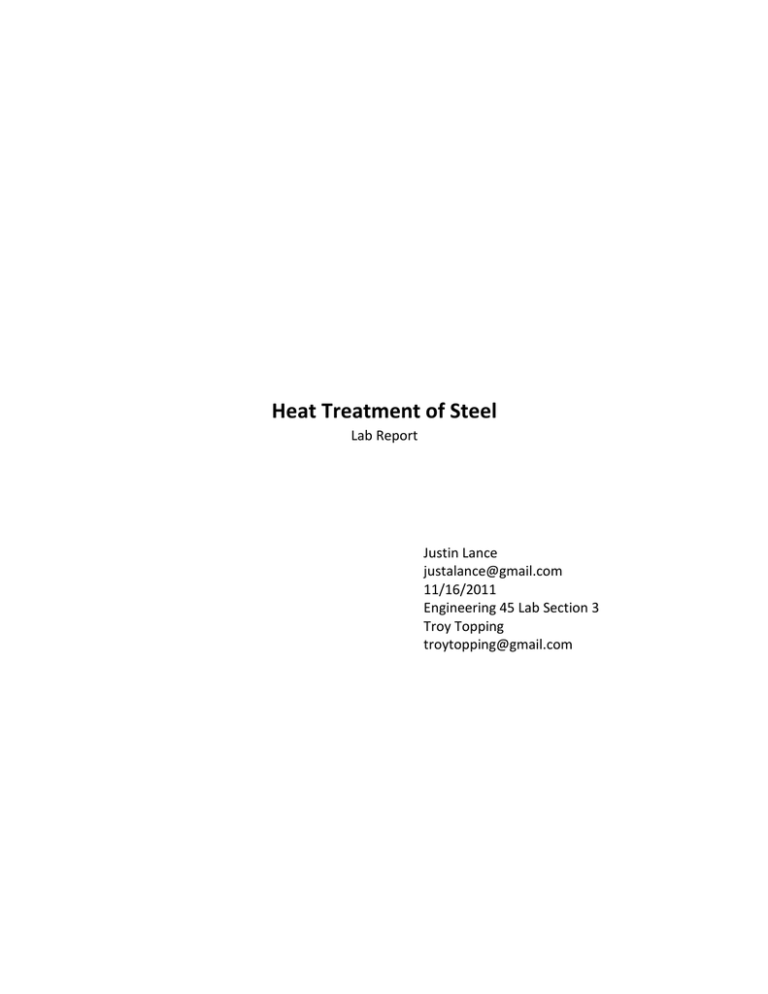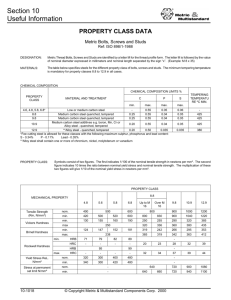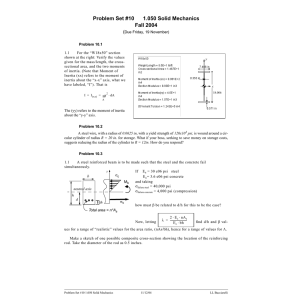Lab Report: Heat Treatment of Steel
advertisement

Heat Treatment of Steel Lab Report Justin Lance justalance@gmail.com 11/16/2011 Engineering 45 Lab Section 3 Troy Topping troytopping@gmail.com Heat Treatment of Steel Lab Report ABSTRACT We observed how the properties of 4140 steel vary with the heat treatment condition. We prepared six different samples in three different heat treatment configurations and performed tensile tests on them using the universal testing machine (UTM). Using data from hand measurements, we found that the annealed (O) samples had approximately 50% more ductility than the as-received (AR) samples and the quenched and tempered (QT) samples. We analyzed the data collected during the tensile test, and found the ultimate tensile strength (UTS) and yield strength for each heat treatment configuration. The QT samples had a UTS almost 100% larger than the O samples. However, the elastic modulus for all three sample types was approximately the same. Heat treatment has a tremendous impact on some of the properties of materials used by engineers, and the effects of heat treatment should always be considered. INTRODUCTION In this experiment we explored the effects of heat treatment on the material properties of 4140 Steel. We studied three different heat treatment configurations; as-received, fully annealed, and quenched and tempered. The fully annealed condition is reached by heating the steel enough to turn into austenite, an FCC phase of steel, and then slow cooling it to room temperature. This allows enough time for pearlite to form, which gives the steel a lower strength but high ductility. Quenching is used to quickly reduce the temperature of the steel, preventing the pearlite from forming. Instead martensite is formed, an extremely strong but brittle phase of steel. Quenched steel is usually tempered, which is heating the steel to a temperature below the eutectoid temperature for a specific period of time. This gives the steel enough energy to allow the carbon atoms within the martensite to diffuse to lower energy points, forming tempered martensite. This process reduces the strength, but increases ductility. Thus we can see that the specific heat treatment of a material is extremely important to a design engineer. As the properties can vary by quite a bit, it is important to design capacities and safety factors around the correct heat treatment’s properties. PROCEDURE 1. Heat treatment a. Fully annealed samples i. Heat in oven to 1600°F ii. Turn off oven, leaving the sample inside until cool. b. Quenched and tempered i. Heat in carbon rich environment to 1600°F for 1 hour ii. Remove from oven and immediately quench in oil. iii. Perform a RHc hardness test iv. Heat to 1000°F for 1 hour v. Return to room temperature 2. Tensile testing a. Perform a Rockwell Hardness B test on AR and O samples and Rockwell Hardness C test on QT samples b. Measure and record sample diameter c. Create indents for gage length 2” apart and record actual distance between marks. d. Insert into UTM and attach extensometer ENGR45 LAB Page 2 of 9 Rev C Heat Treatment of Steel Lab Report e. Begin tensile test f. Remove extensometer at 0.2 strain for O samples, and at 0.1 strain for AR and QT samples. g. Continue testing until sample fails h. Measure and record final diameter and gage length 3. Data analysis a. Export data to excel format b. Plot stress vs. strain up to removal of extensometer. c. Using measured final strain and breaking stress, plot breaking point d. Plot estimate of stress strain curve from last strain data to breaking point e. Label ultimate tensile strength (UTS) and breaking strengths f. On a separate graph, plot stress strain up to .025 strain for each sample type g. Plot line from .002 strain parallel to the elastic region of the curve. h. Label point where stress strain curve and line intersect as 0.2% yield strength. RESULTS The data shown in tables 1-3 illustrates some interesting trends. It is clear that annealing gives a material a much longer percent elongation than quenching and tempering, but also a much lower yield strength and tensile strength. The as-received sample’s properties did not match up to any heat treatment literature data. The data was closest to annealed, with a very similar UTS, but with a lower percent elongation and slightly higher yield strength. Thus it is reasonable to guess that the AR samples were annealed and then work hardened during their fabrication. TABLE 1 – RESULTS FOR 4140 ANNEALED 4140-O (a) 4140-O (b) Elastic Modulus Yield Strength UTS Hardness (RHb) % Elongation % Reduction in Area 28,891 ksi 54,000 psi 98,467 psi 81.8 26.15% 49.22% 28,891 ksi 54,000 psi 97,928 psi 79.1 27.00% 48.41% TABLE 2 – RESULTS FOR 4140 AS-RECEIVED 4140-AR (a) 4140-AR (b) Elastic Modulus Yield Strength UTS Hardness (RHb) % Elongation % Reduction in Area ENGR45 LAB 29,921 ksi 70,000 psi 103,290 psi 98.2 16.02% 40.52% 29,921 ksi 70,000 psi 103,230 psi 96.5 15.46% 34.44% Page 3 of 9 Literature Values (see references) 29700 ksi 60200 psi 95,000 psi 92 25.7% 56.9% Average % Difference 1.3% 10.3% 3.4% 12.5% 3.4% 14.2% Literature Values (see references) 29700 ksi 60200 psi 95,000 psi 92 25.7% 56.9% Average % Difference 0.7% 16% 8.7% 5.8% 38.8% 34.13% Rev C Heat Treatment of Steel Lab Report TABLE 3 – RESULTS FOR 4140 QUENCHED AND TEMPERED 4140-QT (a) 4140-QT (b) Literature Values (see references) 28,920 ksi 29700 ksi Elastic Modulus 28,920 ksi 176000 psi 180500 psi 161000 psi Yield Strength 187,089 psi 191,453 171900 psi UTS 49.5 51.5 57 As Quenched Hardness (RHc) 33.3 37 Hardness (RHc) 27 18.62 14.23 15.4% % Elongation 47.03 48.76 55.7% % Reduction in Area Average % Difference 2.6% 10.7% 10.1% 11% 18.5% 6.7% 14.0% Figure 1 – Stress/Strain Plot from all Tensile Tests ENGR45 LAB Page 4 of 9 Rev C Heat Treatment of Steel Lab Report Figure 2 – 4140 As-received Stress/Strain Plot to 0.8% Strain Showing 0.2% Yield Strength Figure 3 - 4140 Annealed Stress/Strain Plot to 1.4% Strain Showing 0.2% Yield Strength ENGR45 LAB Page 5 of 9 Rev C Heat Treatment of Steel Lab Report Figure 4 - 4140 Quenched and Tempered Stress/Strain Plot to 1% Strain Showing 0.2% Yield Strength DISCUSSION As can been seen from the results of this experiment, steel can have a wide range of properties depending on its heat treatment state. Annealing reforms the grain structure and produces the softest and most ductile material. Austenitizing involves heating steel hot enough to form austentite. This changes the crystal structure, and allows pearlite and bainite to reform into different phases. Quenching involves quickly cooling a material to form martensite, which is an extremely strong but brittle phase of steel. Tempering quenched steel gives enough energy for the carbon atoms to diffuse, which decreases the strength but increases the ductility. This subject is extremely important for any engineer as the heat treatment condition of the steel greatly influences its material properties. If a hard, brittle object such as a cutting tool were required, one would want to quench the steel from the austenite region. Alternatively, if a soft and easy to machine material is desired, annealing before cutting operations is ideal. The elastic moduli are approximately equal for all of the specimens. This is expected since during elastic deformation the strain is due to increasing the inter-atomic spacing. Since heat treatment doesn’t affect the bonding distance, the elastic modulus should be constant. ENGR45 LAB Page 6 of 9 Rev C Heat Treatment of Steel Lab Report TABLE 4 – UTS AND BREAKING STRENGTH Sample Average UTS 189,271 psi Quenched and Tempered 98,198 psi Annealed 103,260 psi As-received Average Breaking Strength 94,513 psi 71,473 psi 82,479 psi The breaking strengths appear to be similar for all the heat treatments even though the quenched and tempered UTS is almost 100% higher than annealed and as-received. This is probably due to the fact that during crack propagation the energy stored in elastic strain is released and helps the crack propagate. The energy stored in a material with high UTS, combined with its brittleness, appears to cause the breaking strengths to even out. TABLE 5 – PHASES AND CONSTITUENTS PRESENT IN 4140 STEEL Heat Phases Present Constituents How Microstructure is formed Treatment Present Body-centered Martensite When austenite is rapidly cooled, the As tetragonal (BCT) face centered cubic structure distorts into Quenched a body centered tetragonal. This phase change occurs very quickly once the austenite cools enough. α ferrite + Fe3C Tempered Martensite is heated up, giving enough Quenched cementite Martensite energy for carbon atoms in the BCT and structure to diffuse, resulting in very fine Tempered Fe3C spheres in a matrix of α ferrite. α ferrite + Fe3C Primary α + Austenite is cooled very slowly. This Annealed cementite Pearlite allows more time for pearlite structure to form, resulting in thick bands of ferrite and cementite. α ferrite + Fe C Primary α + The austenite is air cooled. This allows Normalized 3 cementite Pearlite enough time for pearlite to form, but less than with annealing, resulting in very fine bands of ferrite and cementite. How microstructures influence mechanical properties Annealed – microstructure has thick bands of Pearlite – minimal phase boundaries compared to other possible microstructures, which results in more ductility and lower hardness. Thicker bands of pearlite form when steel is cooled very slowly. Normalized – microstructure has fine bands of Pearlite – more phase boundaries than annealed, but not as much as other methods, gives more hardness and less ductility. Thinner bands of pearlite form when steel is air-cooled. As quenched – microstructure is martensite, a super-carbon-saturated steel solution – extremely hard and brittle, has almost no ductility. Successful formation of martensite depends on how rapidly the steel is cooled. Quenched and tempered – Microstructure has extremely small spheres of cementite in a matrix of martensite – very fine structure has a very large amount of phase boundaries, can be very hard but less brittle than as quenched. Material properties ENGR45 LAB Page 7 of 9 Rev C Heat Treatment of Steel Lab Report depend on size of cementite spheres which vary based on tempering temperature and time. Figure 5 – Material properties in quenched and tempered 4140 steel We can see from Figure 5 that for quenched and tempered samples, the strength and hardness values decline with higher tempering temperature and that ductility increases. This is to be expected because the carbon is diffusing out of the martensite and forming small sphere-like particles of Fe3C. As the tempering temperature rises, the rate of diffusion increases, which would allow larger Fe3C particles. Larger particles results in less phase boundary area, lower strength, and higher ductility. The experimental data did not match up with the literature data. However, with the exception of hardness, the values match up with the values for 800°F. One explanation for this is that the tempering oven was not operating at the expected temperature. If a part that requires machining is also required to be hard, it is ideal to perform the machining operations while the metal is in the annealed state as this is when it is most ductile and soft. This allows quicker machining operations with less tool wear. After machining, it is then possible to quench and temper the final part, giving the desired hardness without significantly affecting the dimensional stability of the part. In designing a steel chisel, a couple of material properties are important. The material needs to be very hard, but also needs good impact and chip resistance. There are several ways to achieve these qualities. The first option is to forge the tool to the desired shape, then quench ENGR45 LAB Page 8 of 9 Rev C Heat Treatment of Steel Lab Report and temper the material to the desired qualities. However, this requires a trade-off between hardness and impact resistance when selecting the tempering temperature. Another option is to case harden the tool, which causes the surface to be very hard, but leaves the interior ductile and thus impact resistant. It might be possible to achieve similar results by partially quenching the tool to form some martensite on the surface, and then allowing the remaining austenite to form into pearlite or bainite. CONCLUSION This experiment demonstrated some key differences in material properties of several heat treatments for 4140 steel. Annealing creates a soft and ductile material that is easy to machine and perform other operations on. Quenching creates a very hard and brittle material that has extremely high yield and tensile strengths. Tempering quenched steel softens the steel and provides a tradeoff between the hard and strong quenched steel and the soft annealed steel. Engineers are benefited by an understanding of heat treatment because they are better able to predict how a material will perform when loaded if they know the heat treatment state of that material. Thus the results of this experiment, and others like it available in literature, are very important for design and manufacturing engineers. REFERENCES RC to BHN Conversion Chart - http://www.carbidedepot.com/formulas-hardness.htm Matweb.com (see data sheets in appendix) o Literature values for AR and O - AISI 4140 Steel, annealed at 815°C (1500°F) furnace cooled 11°C (20°F)/hour to 665°C (1230°F), air cooled, 25 mm (1 in.) round o Literature values for QT - AISI 4140 Steel, oil quenched, 13 mm (0.5 in.) round [845°C (1550°F) quench, 540°C (1000°F) temper] Background Unit: Heat Treatment of Steel, Sacramento State University. Properties of Selected Carbon and Alloy Steels, Materials & Processing Databook ’81, Metal Process, Vol 120, No. 1, American Society for Metals (1981) APPENDIX See attached documents. Data Sheet: Heat Treatment of Steel Lab AISI 4140 Steel, annealed at 815°C… AISI 4140 Steel, oil quenched… Properties of selected carbon… Sample Calculations Average Percent Difference: Percent Elongation: ENGR45 LAB Page 9 of 9 Rev C


